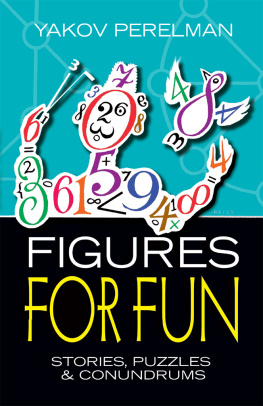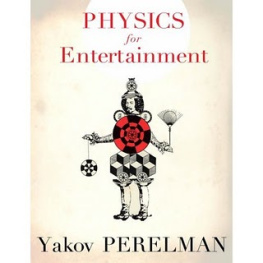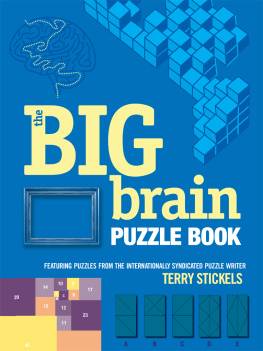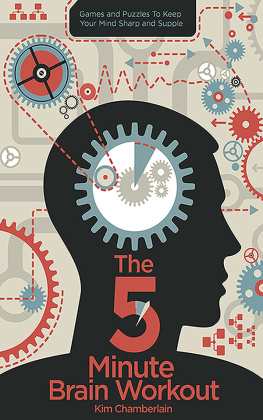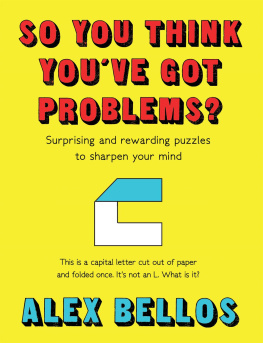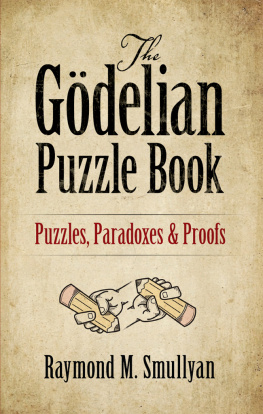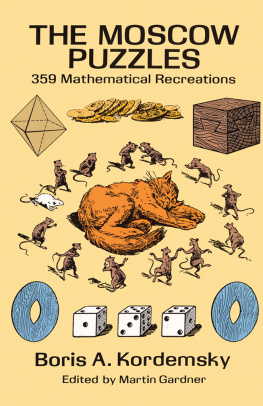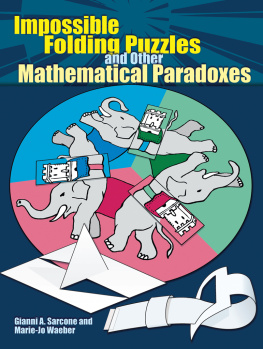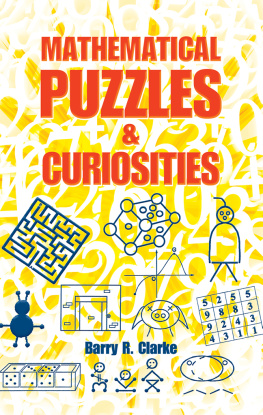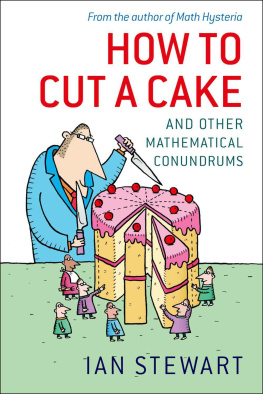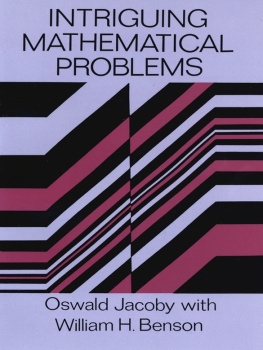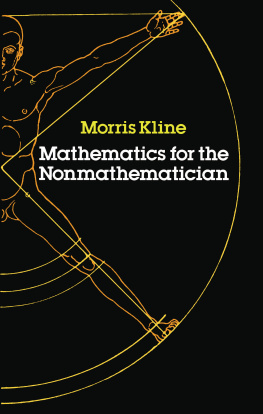FIGURES
FOR FUN
Stories, Puzzles and Conundrums
Yakov Perelman
Dover Publications, Inc.
Mineola, New York
Bibliographical Note
Figures for Fun: Stories, Puzzles and Conundrums, first published by Dover Publications, Inc., in 2015, is an unabridged republication of the American edition of Figures for Fun: Stories and Conundrums, originally published by the Frederick Ungar Publishing Company, New York, in 1965.
Library of Congress Cataloging-in-Publication Data
Perelman, IA. I. (IAkov Isidorovich), 1882-1942. [Zhivaia matematika. English]
Figures for fun : stories, puzzles, and conundrums / Yakov Perelman.
pages cm
Originally published in English by: Moscow : Foreign Languages Pub. House, 1957.
Includes bibliographical references and indexes.
eISBN-13: 978-0-486-80345-6
1. Mathematical recreations. I. Title.
QA95.P363 2015
510dc23
2014040410
International Standard Book Number
ISBN-13: 978-0-486-79568-3
ISBN-10: 0-486-79568-3
Manufactured in the United States by Courier Corporation
79568301 2015
www.doverpublications.com
CONTENTS
PREFACE
To read and enjoy this book it will suffice to possess a modest knowledge of mathematics, i.e., knowledge of arithmetical rules and elementary geometry. Very few problems require the ability of forming and solving equationsand the simplest at that.
The table of contents, as you may see, is quite diversified: the subjects range from a motley collection of conundrums and mathematical stunts to useful practical problems on counting and measuring. The author has done everything to make his book as fresh as possible, avoiding repetition of all that has already appeared in his other works (Tricks and Amusements. Interesting Problems, etc.). The reader will find a hundred or so brain-teasers that have not been included in earlier books. Number Giantsis adapted from one of the authors earlier pamphlets, with four new stories added.
CHAPTER I
BRAIN-TEASERS FOR LUNCH
It was raining.... We had just sat down for lunch at our holiday home when one of the guests asked us whether we would like to hear what had happened to him in the morning.
Everyone assented, and he began.
A SQUIRREL IN THE GLADE. I had quite a bit of fun playing hide-and-seek with a squirrel, he said. You know that little round glade with a lone birch in the centre? It was on this tree that a squirrel was hiding from me. As I emerged from a thicket, I saw its snout and two bright little eyes peeping from behind the trunk. I wanted to see the little animal, so I started circling round along the edge of the glade, mindful of keeping the distance in order not to scare it. I did four rounds, but the little cheat kept backing away from me, eyeing me suspiciously from behind the tree. Try as I did, I just could not see its back.
But you have just said yourself that you circled round the tree four times, one of the listeners interjected.
Round the tree, yes, but not round the squirrel.
But the squirrel was on the tree, wasnt it?
So it was.
Well, that means you circled round the squirrel too.
Call that circling round the squirrel when I didnt see its back?
What has its back to do with the whole thing? The squirrel was on the tree in the centre of the glade and you circled round the tree. In other words, you circled round the squirrel.
Oh no, I didnt. Let us assume that Im circling round you and you keep turning, showing me just your face. Gall that circling round you?
Of course, what else can you call it?
You mean Im circling round you though Im never behind you and never see your back?
Forget the back! Youre circling round me and thats what counts. What has the back to do with it?
Wait. Tell me, whats circling round anything? The way I understand it, its moving in such a manner so as to see the object Im moving around from all sides. Am I right, professor? He turned to an old man at our table.
Your whole argument is essentially one about a word, the professor replied. What you should do first is agree on the definition of circling. How do you understand the words circle round an object? There are two ways of understanding that. Firstly, its moving round an object that is in the centre of a circle. Secondly, its moving round an object in such a way as to see all its sides. If you insist on the first meaning, then you walked round the squirrel four times. If its the second that you hold to, then you did not walk round it at all. Theres really no ground for an argument here, that is, if you two speak the same language and understand words in the same way.
All right, I grant there are two meanings. But which is the correct one?
Thats not the way to put the question. You can agree about anything. The question is, which of the two meanings is the more generally accepted? In my opinion, its the first and heres why. The sun, as you know, does a complete circuit in 26 days....
Does the sun revolve?
Of course, it does, like the earth. Just imagine, for instance, that it would take not 26 days, but 365 days, i.e., a whole year, to do so. If this were the case, the earth would see only one side of the sun, that is, only its face. And yet, can anyone claim that the earth does not revolve round the sun?
Yes, now its clear that I circled round the squirrel after all.
Ive a suggestion, comrades! one of the company shouted. Its raining now, no one is going out, so lets play riddles. The squirrel riddle was a good beginning. Let each think of some brain-teaser.
I give up if they have anything to do with algebra or geometry, a young woman said.
Me too, another joined in.
No, we must all play; but well promise to refrain from any algebraical or geometrical formulas, except, perhaps, the most elementary ones. Any objections?
None! the others chorussed. Lets go.
One more thing. Let professor be our judge.
SCHOOL-GROUPS. We have five extra-curricular groups at school, a Young Pioneer began. Theyre political, literary, photographic, chess and choral groups. The political group meets every other day, the literary every third day, the photographic every fourth day, the chess every fifth day and the choral every sixth day. These five groups first met on January 1 and thenceforth meetings were held according to schedule. The question is, how many times did all the five meet on the one and same day in the first quarter (January 1 excluded)?
Was it a Leap Year?
No.
In other words, there were 90 days in the first quarter.
Right.
Let me add another question, the professor broke in. Its this: how many days were there when none of the groups met in that first quarter?
So, theres a catch to it? Therell be no other evening when all the five groups meet and no evening when some do not meet. Thats clear!
Why?
Dont know. But Ive a feeling theres a catch.
Comrades! said the man who had suggested the game. We wont reveal the results now. Lets have more time to think about them. Professor will announce the answers at supper.
WHO COUNTED MORE? Two persons, one standing at the door of his house and the other walking up and down the pavement, were counting passers-by for a whole hour. Who counted more?
Naturally the one walking up and down, said somebody at the end of the table.
Well know the answer at supper, the professor said. Next!
GRANDFATHER AND GRANDSON. In 1932 I was as old as the last two digits of my birth year. When I mentioned this interesting coincidence to my grandfather, he surprised me by saying that the same applied to him too. I thought that impossible....

